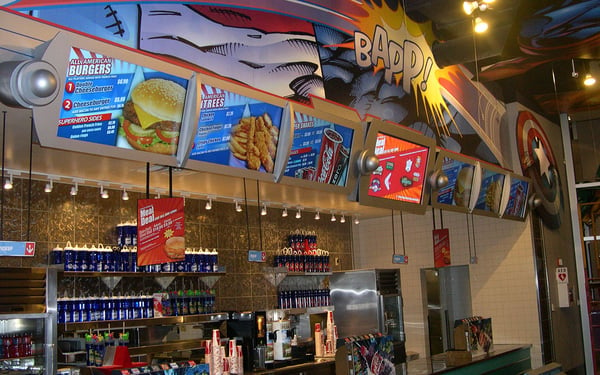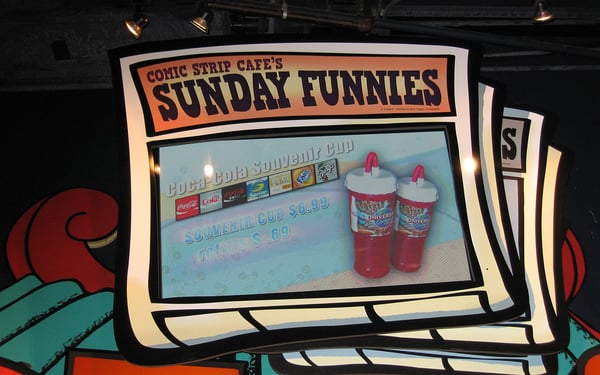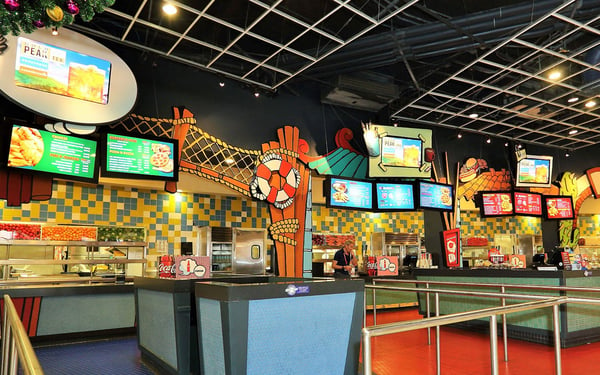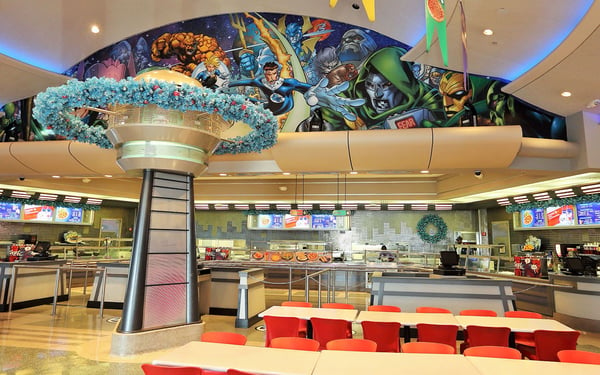Creating a Stellar Guest Experience With Theme Park Digital Signage
Introduction
In the dynamic realm of theme parks, where magic and wonder come to life, the guest experience is paramount. From the moment visitors step through your gates, their journey should be seamless, engaging, and unforgettable.
Gone are the days of static information boards; today, theme parks are leveraging cutting-edge digital signage solutions to captivate audiences, streamline their operations, and create a truly immersive adventure. Join us as we illustrate the transformative impact of theme park digital signage on the guest experience. From enhancing wayfinding, to delivering real-time updates, the possibilities are as limitless as the imagination itself.

How Are Theme Parks Using Digital Signage?
Information Dissemination
One of the strongest functional uses of theme park digital signage is for providing useful information for your guests. A great place to start is with wayfinding. Navigating theme parks can be challenging, especially when you don’t know which areas of the park are the busiest, and what rides you want to prioritize. Using your signage to provide interactive maps that display the different areas of the park and where attractions can be found greatly aids in ensuring your guests can navigate the park smoothly. Your guests should have the ability to scroll and zoom in on certain sectors of the park, ensuring they have all the information they need to make informed decisions on where to visit next.
Theme park digital signage can also be used to display event schedules such as show times, parade schedules, and special events to ensure all visitors are kept in the loop on the day’s events. This has the potential to increase attendance at these special events. Many parks also feature safety guidelines and procedures on their signage to ensure that visitors adhere to park rules during their visit.
The unique ability of digital signage to update in real-time makes it an invaluable resource for providing critical data and updates to your visitors on things like weather. Your guests will appreciate notice that rain is in the forecast for later in the day, or that rain is expected to stop at a certain time. This information aids your visitors in planning around potential bad weather, helping them best manage their time in the park.
Theme parks are also leveraging digital signage to disseminate critical messages across their parks in the event of emergencies like lost children, evacuations, and more. In the event of an emergency, it is of the utmost importance that your park can effectively communicate with staff and visitors in real-time. Digital signage is an effective communication tool for transmitting timely messages to guests.
The use of large format LED screens is important for making sure your theme park digital signage is visible to a large audience. Instead of relying only on smaller screens that are easily visible from 10-15 feet, many theme parks choose to leverage massive, billboard-like screens that hundreds of visitors can see simultaneously. These larger screens provide the opportunity to spotlight your most high-priority messages and communications to a large audience.

Enhanced Engagement
Digital signage has become so widespread because it is more engaging than static signage, largely due to the ability to display motion and more eye-catching visuals. Unlike static signage, people can interact with digital signage via touchscreens. Many theme parks are using interactive theme park digital signage to offer games and quizzes that improve immersion and the overall guest experience, especially for those who are waiting in lines.
Your theme park’s signage can also integrate with photo booths. This enables your park to beam pictures taken on rides to larger boards in real-time, giving visitors the chance to see themselves featured in the park and even share the images on social media. This adds a layer of personalization to the visitor experience and gives your visitors the chance to interact with your signage.
Queue Management
It’s no secret that wait times at theme parks can be extraordinarily long. There’s a reason items like “Fast Passes” are moneymakers. Regardless of your age, it is no fun to wait hours in line for a ride. This is a major reason why industry giants like Disney have implemented technology to analyze which sections of their parks are busiest. In the future, parks may display this data directly on their theme park digital signage to show visitors what areas of the park are most crowded (think a heat map!).
Although this is still a work in progress for many parks, digital theme park signage still plays a valuable role in reducing perceived wait times and improving the customer experience in the event of long waits.
Many theme parks display projected wait times for rides and have their ride attendants adjust the wait time in real-time. This streamlines visitors' decision-making process by providing an idea of how long they will have to wait in line. Many theme park visitors are working with a very limited amount of time, and are looking to make the most efficient decisions possible. Providing a “heads-up” on how long they should expect to wait in a queue helps make this decision-making process considerably easier. However, keep in mind the importance of ensuring this information is accurate. If your signage displays a 30-minute wait time and a patron waits 90 minutes for that ride, displaying the projected wait time actually harms the guest experience. If your park is going to use its digital signage to communicate wait times, make sure it is doing so accurately.
Another innovative usage of digital signage to decrease perceived wait time is real-time updates and countdowns displaying when the ride next departs. This gives visitors an idea of how often rides are leaving, and the visual of the countdown builds anticipation and makes waiting a bit more tolerable.
Of course, digital theme park signage can also shorten perceived wait time by showing videos and content to those in queues. Interactive activities that engage visitors (like trivia) are a great way to help them pass the time while waiting in line.
Lastly, the creation of self-service ticketing kiosks. Creating digital ticketing kiosks can help reduce lines at your gates, and provide the option for your visitors to serve themselves. Although some visitors are likely to have questions as to what package is right for them, more regular visitors will appreciate the ease of a self-service alternative.
It is important to note that anytime your park has customers waiting in queues, you must take advantage of the opportunity. People waiting in queues are a captive audience, and engaging signage displays can easily capture and keep their attention. Queues present a tremendous opportunity for cross-promotion and upselling such as pointing guests towards higher-end restaurants and sharing information on upgrading a season pass. Make a strong investment in the messaging and on-screen content you display to your queued visitors, and you are likely to reap major rewards.

Promotions and Advertising
Digital theme park signage of course provides an excellent opportunity for promoting different aspects of your park, from merchandise, to special offers and discounts, to dining options. The use of motion not only enables your amusement park to better capture the attention of your audience, but also better communicate the appeal of restaurants, food, and more by using stimulating visuals.
Digital concession boards are becoming more and more common in theme parks not only because they provide a better visual depiction of menu options, but because they can be easily adjusted based on factors like time of day and weather. Your park is likely to sell more hot chocolate or coffee on colder days, and more ice cream and water on warmer days. Leveraging digital concessions boards enables your park to promote and prioritize in-demand items in real-time, thereby maximizing concession sales.
This principle applies to more than just concessions. On rainy days, your park can easily promote rain jackets, ponchos, and other apparel for sale at merchandise stands to help visitors make the most out of their day despite bad weather.
Intuitive theme park digital signage also makes it simple to run themed promotions based on seasons and particular events, making the guest experience as immersive as possible. Leveraging customized content across your park is also extraordinarily useful for segmenting different areas of your park based on their themes.
Last but certainly not least, leveraging theme park digital signage allows you to sell ad space to other businesses to generate even more revenue. If you choose to go down this path, make sure your partners’ ad creatives are up to par. You do not want a poor ad experience put forth by one of your partners to reflect negatively on your theme park.

Operational Efficiency
Beyond the visual makeover theme park digital signage provides, the operational efficiency it can create is just as valuable. In addition to enhancing communication across your park with internal employee messages and emergency announcements, managing digital signage is immensely easier than managing traditional signage.
A great digital signage CMS centralizes all of your signage displays in one location, and makes it simple to swap out creatives across your park with the click of a button. As we discussed earlier, this makes it simple to adjust your signage based on the weather, time of day, or any holidays or promotions. Menu boards (even some digital boards) are typically extremely labor-intensive to update, but a great CMS complete with integrations with your point-of-sale technology eliminates this troublesome process. The result? Your theme park can benefit immensely from real-time menu adjustments that fit the changing needs and preferences of your guests.
If things do happen to go wrong with your signage and you experience an outage that robs you of the operational efficiency you are striving for, make sure your signage partner has a support team that is ready and willing to act quickly. Your support needs require the utmost attention, especially when your business relies on its signage to drive revenue and communicate urgent messages. Be sure to partner with a signage provider that can provide timely on-site or remote support to help get your signage up and running as soon as possible.
Data Collection and Analysis
Another way digital signage can completely reinvent your park’s promotional activities is by collecting data on visitor interactions, enabling your park to gain insights into preferences, popular attractions, and overall engagement.
DEEL Media is currently working with one of our clients to analyze what content initiatives are driving revenue by collecting data on how long certain visuals played on certain screens, and tying that data back to sales data. This analysis identifies any correlations between on-screen content and revenue, informing businesses what creatives are most effective at driving sales. Most theme parks are barely scratching the surface of tying their digital signage to actual revenue outputs, but the technology to analyze this relationship has absolutely arrived, and will likely shift to the forefront in the coming years. Make sure your park doesn’t miss out!
Conclusion
In the ever-evolving world of theme park entertainment, digital signage has become a transformative force for revolutionizing the guest experience. Beyond serving as a vehicle for information dissemination, digital signage orchestrates improved queue management, engages visitors with interactive elements, and optimizes promotional strategies based on real-time conditions. It can also become a cornerstone of operational efficiency, centralizing signage management and streamlining real-time updates. As an immersive storytelling platform, digital signage not only captivates audiences with dynamic visuals, but also provides invaluable data insights that enable parks to correlate content with revenue. The integration of digital signage marks a paradigm shift where theme parks transcend static communication and embrace a dynamic, data-driven future that enhances guest engagement, operational agility, and revenue-generation possibilities.
If you are interested in learning more about how your theme park can transform itself with digital signage, we’d be glad to help. DEEL Media has worked with industry giants such as Universal Studios to transform their theme park signage, and we’d love to work with you as well. Simply schedule a meeting with our team, or give us a call at 770-619-1225.
Meet The Author
Bill Clapes
Author
In the 1990’s Bill pioneered the use of Internet technologies in the restaurant industry and in 1996 was cited as “Innovator of the Year” by Internet Week Magazine. Co-founding DEEL in 2009 marked the culmination of years in film, television, audio visual, interactive, Internet and restaurant technologies experience. As President & CEO Bill currently leads DEEL’s blueprint for growth and strategic business partnerships.
What is Digital Signage, And How is it Different From Regular Signage?
What is Digital Signage, And How is it Different From Regular Signage?
In technical terms, digital signage refers to the use of digital displays or screens to present information, advertisements, or other forms of content. It involves the use of technologies such as LCD, LED, or projection screens to display multimedia content, including images, videos, text, and interactive elements. Simply put, it is a more engaging way to display messages than traditional signage.
You can find digital signage everywhere, from retail stores, to airports, to hotels, to restaurants, to schools. It serves as a dynamic and flexible communication tool that allows businesses and organizations to deliver targeted messages to their audience.
The first key difference between digital signage and run-of-the-mill signage is the ability to display crystal-clear, dynamic content. This can completely transform the experience of a shopper, visitor, or whoever is viewing your signage. The bright display is hard to ignore, especially when it is in video format. Digital signage is simply more effective at attracting attention than conventional signage. Think about your personal experiences. Which menu board do you think commands more attention, a chalkboard with the day’s specials, or a visual display with bright colors and real, moving imagery showcasing one of the day’s specials?
Beyond higher engagement, another major difference between digital signage and traditional signage is the flexibility provided by digital signage. Rather than taking down your signage every time you want to communicate a new message or make an edit, digital signage enables you to store all of your content in one centralized location, and make changes to display with the push of a button. This makes life considerably easier for any organization that runs promotions or is frequently making tweaks to its offerings.
How Does Digital Signage Make an Impact?
How Does Digital Signage Make an Impact?
More Sales: Perhaps the most alluring impact of digital signage is the tangible impact in sales organizations experience after making the switch. This makes perfect sense logically. Again, consider your own personal experience.
Imagine yourself at a movie theater. Are you more likely to buy popcorn upon seeing a generic sign that says “snacks” or after seeing some high-resolution footage of kernels popping, butter being poured, and popcorn being eaten (we are making ourselves hungry)! The answer is pretty clear.
This does not only apply to the world of food. Retail stores, and even convenience stores and gas stations tend to see considerable upticks in sales when they are able to better visually communicate their products, and showcase their promotions and sales offers in an engaging, compelling manner.
Digital signage displays vibrant and dynamic visual content that attracts attention and engages customers. Compared to traditional static signage, digital displays have a higher chance of capturing people's interest. Eye-catching videos, animations, and interactive elements create a memorable and immersive experience, drawing more customers into stores or promotions.
Speaking of promotions, digital signage makes it easier for businesses to promote certain offers in a strategic manner and capitalize on customer interest at a particular time of day or other external factors. This leads to more downstream sales and revenue.
Lastly, let’s consider the impact of digital signage on your brand in general. By displaying engaging, helpful content, such as product demonstrations, customer testimonials, or usage tips, businesses can educate customers and guide them toward making informed purchase decisions. Additionally, digital signage enables businesses to enhance their brand perception by showcasing their values, expertise, or unique selling points. These factors positively influence customer perception, trust, and loyalty, leading to increased sales and repeat business.
Improved Customer Experience: The impact that digital signage has on customer experience is monumental. There are three key ways digital signage improves the customer experience that we’d like to focus on:
More Engaging Visual Content: First and foremost, digital signage allows businesses to display captivating and dynamic visual content, such as videos, images, animations and motion graphics, and interactive elements. This form of visual stimulation captures customers' attention and engages them with the brand or product being promoted in a manner that is far more effective than traditional signage. By presenting visually appealing and relevant content, digital signage creates a more immersive and memorable experience for customers, increasing their overall satisfaction.
Real-Time Information and Personalization: When leveraging digital signage, your business has the opportunity to deliver real-time information and updates to customers. Whether it's displaying current promotions, product features, or event schedules, digital signage ensures that customers are informed and up-to-date, and are being pointed in the direction you want. Additionally, with the integration of data analytics and customer profiling, businesses can personalize content based on customer preferences and demographics. This personalization enhances the relevance of the displayed information, making it more meaningful and impactful for customers.
Improved Wayfinding and Navigation: In many industries such as retail, movie theaters, and theme parks, digital signage can greatly enhance the customer experience by assisting with wayfinding and navigation. In large or complex environments such as shopping malls, or theme parks, digital signage can provide clear and interactive directions to specific locations, helping customers find their desired destinations easily. By reducing confusion and saving customers' time, digital signage improves the overall convenience and satisfaction of their experience within a particular space.
Simplified Operations: When deploying digital signage, your business reaps the benefits of being able to centrally manage and update content across multiple locations or displays. Whether you have one location or 500, you can easily create, schedule, and distribute all of your signage content from a single centralized platform. This eliminates the need for manual content updates on individual displays, saving time and effort for business operators. It also ensures consistency in messaging and branding across different locations, streamlining the content management process, and ensuring compliance with brand standards.
Digital signage also enables remote management and monitoring of displays, eliminating the need for on-site adjustments or maintenance. Through network connectivity, businesses can remotely control and update content, adjust display settings, and troubleshoot issues. This capability simplifies operations by reducing the need for physical intervention, allowing businesses to efficiently manage and maintain displays from a central location. This saves time and resources while ensuring that the signage is functioning optimally.
Lastly, digital signage enables businesses to predefine schedules for content playback, ensuring that the right content is displayed at the right time. This eliminates the need for manual content changes or monitoring. Businesses can also target content based on factors such as location, demographics, or time of day, tailoring the messaging to specific audiences. This targeted approach simplifies operations by delivering relevant content automatically, without requiring constant manual adjustments.
What Does a Great Digital Signage Solution Look Like?
- Scalability and Reliability: Perhaps the most important aspect of a great digital signage solution is the ability to support your current and future needs. Consider your provider’s ability to scale the digital signage network as your business grows. You don’t want to decide on one solution, only for it to not fit your needs in a few years. Look for a provider with a robust infrastructure that ensures reliable uptime and performance, minimizing disruptions and downtime. There is nothing more important than quality, and you must be confident in your provider’s commitment to excellence. After all, what is digital signage worth if it's not operating properly?
- Customer Support and Service: An oft-overlooked but incredibly important aspect of selecting a digital signage solution is the level of customer support and service offered by the provider. Responsive and knowledgeable customer support can make a massive difference in resolving issues quickly and ensuring a smooth experience. Consider the provider's support channels, response times, and availability of documentation and resources. It is inevitable that you will need help at some point in your signage journey. Make sure you have a support team that is ready when the time comes.
- Strong Content Management System (CMS): A robust and user-friendly CMS is essential for creating, managing, and scheduling content across your digital signage network. Look for a provider that offers an intuitive CMS with features like drag-and-drop content creation, template libraries, playlist scheduling, and remote content updates. A powerful CMS simplifies content management and ensures the smooth operation of your digital signage displays.
- Display Management and Control: The ability to remotely manage and control your digital signage displays is critical for efficient operations. A good provider should offer a centralized management platform that allows you to monitor the status of your displays, adjust settings, troubleshoot issues, and perform updates remotely. Look for features like screen synchronization that can really boost your in-store experience.
- Integration Capabilities: Your digital signage shouldn’t exist on an island. Consider a provider that offers integration capabilities with other systems and platforms. This includes integration with data sources, such as social media feeds, weather updates, or real-time event information, to enhance the relevance and timeliness of your content. Integration with third-party applications and APIs allows you to extend the functionality of your digital signage and leverage additional data sources.
- Robust Analytics and Reporting: The ability to track and measure the performance of your digital signage campaigns is crucial for evaluating their effectiveness and making data-driven decisions. A reliable digital signage solution should offer analytics and reporting features that provide insights into audience engagement, content performance, and display effectiveness. These analytics help you optimize your content strategy and measure the return on investment (ROI) of your digital signage initiatives.
- More Than Just Signage: You should be looking for a digital signage partner that is just that, a partner. Your provider should be in your corner for all of your digital signage needs, from hardware, to software, to content creation. Your needs are flexible, ensure your digital signage partner is as well. Look to partner with a comprehensive digital signage provider that covers all the bases, and is a one-stop shop for all your needs. This will save you a ton of headaches in the long run.
How Do I Get Started With Digital Signage?
How Do I Get Started With Digital Signage?
- Establish Your Goals: Start by clearly identifying your objectives and goals you seek to accomplish with your digital signage. Are you looking to drive more sales? Improve the customer experience? How about both? Having well-defined goals will guide your content creation and form the foundation of your digital signage strategy.
- Select Hardware: The next step for getting started with digital signage is selecting the necessary hardware components, including display screens, media players or computers, and any required accessories such as mounts or stands. When you are selecting your hardware, consider your store or venue’s layout, where your signage will go, and how much you will need.
- Select Software: You’ll need a robust software that is capable of creating and managing your digital signage content efficiently and effectively. When selecting software, consider things like ease of use, integrations, and scalability. Without great software in your corner, you will not get the most out of your digital signage initiative.
- Create Your Content: Now that your infrastructure is in place, it is time to create visually captivating and engaging content to delight your customers. Your signage is only as good as the content on it. Spare no expense on making sure the content you’ll use on your signage is best-in-class.
- Begin the Installation Process: Once you have your hardware, software, and content ready to go, it is time to install your signage. Ensure it is prominently displayed to attract the attention of your customers. Signage that is sub-optimally installed represents a massive wasted opportunity. Take the time to consider where everything is best positioned before finalizing your installation.
- Test and Monitor Performance: Be sure to thoroughly test your digital signage to make sure it's working properly. Make sure you are comfortable with your CMS and all of its tools, and once your signage is live, keep a close eye on its performance to see how it's impacting your goals. Are you driving more sales? Is your establishment getting better reviews? If you aren’t seeing your desired impact, don't hesitate to make adjustments to improve the results.
There’s one more step in starting your digital signage journey, and that’s calling us. At DEEL Media, we don’t provide signage, we provide solutions. We are equipped to help your organization through every step of the digital signage process, from goal-setting to installation. There is nothing in the world of digital signage we don’t do. If you want to get started with digital signage, contact us today.
Conclusion:So, what is digital signage?
We hope you’re able to answer that question after reading this overview. In short, digital signage is a powerful tool for driving improved outcomes across industries. From retail, to restaurants, to schools, digital signage improves the experience of its viewers and the ambiance of your establishment and improves the chances viewers take your desired action, whether that’s purchasing popcorn, or going to the right location.
When you select a digital signage partner, keep your eyes peeled for critical features like best-in-class support, end-to-end coverage, and of course, reliable performance. When you start your signage journey, start by setting your goals, before deciding on the particulars of your plan including software, hardware, and content creation.
If your business is looking to take its signage to the next level, our team at DEEL Media would love to be of assistance. Our mission is to revolutionize your business with best-in-class, turnkey digital signage solutions that you can rely on day in and day out. We work alongside you as a trusted partner for the entirety of your digital signage journey, and are ready to help you with any need you may have.
Ready to Get Started (Module From Bottom of Homepage)

